 |
|||||||||
|
January/February 2012 Dak To: One Hell Of A Fight BY JOHN PRADOS
Dak To was among the worst. Nestled in the Central Highlands northwest of Kontum, the Dak To Special Forces camp guarded the approaches to an important provincial capital. Established in the summer of 1962, abandoned, then recreated in August 1965, Dak To was threatened, besieged, or attacked repeatedly—notably in 1966, 1969, 1971, and 1972. The 1966 and 1972 battles were particularly fierce. But ask GIs about Dak To and usually it’s 1967 that they remember. Not just any moment of that year—for it is possible to say that a “campaign” took place around Dak To from the spring to the fall—but one specific series of battles that November. The veterans of Dak To participated in an incredible epic of courage, privation, and frustration.
The Kontum area lay across from the tri-border region—the intersection of Cambodia, Laos, and South Vietnam. Hanoi had established its Base Area 609 there, one of its nerve centers in the war. By 1967, the Ho Chi Minh Trail allowed easy communication with this area, which enhanced enemy capabilities. That spring the 1st Brigade of the 101st Airborne Division had engaged the North Vietnamese in a brief but sharp fight, which led MACV Commanding Gen. William C. Westmoreland to lay on a full-scale riposte, Operation Greeley, which began in June and lasted through October. Greeley featured some tough engagements, especially the late-June scrape that pitted the 2nd Battalion of the 503rd Airborne Infantry against the North Vietnamese 24th Regiment. That engagement took place no more than five kilometers from Dak To. There was also an enemy attack on the nearby Tan Canh Special Forces Camp. During these events the whole of the 173rd Airborne Brigade, the parent unit of the 2/503, and the 1st Brigade of the 1st Cavalry Division were pulled into the melee. Infantry sweeps, harassment and interdiction fire, and B-52 strikes continued throughout the summer. But Base Area 609 still loomed across the border where it could not be touched—at least by American troops on the ground. Meanwhile, a full division of first-line NVA regulars gathered there. In a way, Dak To was a battle waiting to happen. Lt. Gen. William R. Rosson took command of MACV’s regional command for this area, I Field Force, in early August. Rosson knew of both Greeley and the companion Operation Paul Revere in Pleiku province. He had worked for a long time with Westmoreland and was an old hand in Indochina, having been part of the original U.S. military aid group in the mid-1950s. He was an excellent choice to lead the U.S. forces in South Vietnam’s Central Highlands. The senior field commander, Maj. Gen. William R. (“Ray”) Peers of the 4th Infantry Division, was an officer commissioned from the ranks with experience in jungle warfare stretching all the way back to Burma in World War II, where he had learned guerrilla tactics from the other side—as an American guerrilla fighting the Japanese. If Dak To was waiting to happen, Rosson and Peers were well equipped to deal with it. Neither they nor Westmoreland knew about Hanoi’s decision to mount an offensive during Tet 1968. That plan, finalized in late July, called for a series of engagements along South Vietnam’s borders that were designed to draw out MACV and Saigon forces. Hanoi also planned a battle in Kontum province, around Dak To. This was the sector of the North Vietnamese B-3 Front led by Maj. Gen. Hoang Minh Thao, a veteran of Dien Bien Phu, and political officer Col. Tran The Mon. Thao’s forces, built around the North Vietnamese 1st Division, included five infantry regiments and the 40th Artillery. Despite Operation Greeley, his bo doi, or soldiers, had had ample time to prepare the battlefield. Attacking GIs would encounter complete defensive systems layered one upon another and separated by intervals of a kilometer or two. The clear intent was to oblige the Americans to fight their way through successive defense lines. Gen. Thao set the stage carefully.
When the People’s Army 24th Regiment faded away that summer, major contacts became scarce in Kontum. Gen. Rosson began to focus elsewhere. Phu Yen province looked like trouble, so he sent the 173rd Airborne Brigade there, leaving behind just one battalion, Maj. James R. Steverton’s 2/503rd Airborne Infantry. It, too, left and was replaced by the 2nd Battalion, 8th Infantry (Mechanized). Kontum was hardly good mech country, though, and the 299th Engineers, responsible for the local roads, most importantly Route 14, had their hands full restoring the bridges blown up in guerrilla actions. So the grunts were mostly occupied in opening the roads. The most dangerous threats were ambushes, mines, and booby traps. The enemy seemed to have hunkered down in its base area across the border. The withdrawal of the airborne brigade would be fortuitous in one respect. The movement by C-130 aircraft took place over several days of rainy weather, which rutted the runway at Dak To’s airstrip. The engineers’ work to restore the strip turned out to be critical to its use when the North Vietnamese emerged from their bases. That happened in the latter half of October. According to a briefing given to Gen. Westmoreland early in December, it was at that time that the U.S. detected the North Vietnamese 1st Division in the tri-border area. Gen. Peers reacted quickly, flooding the hills with LRRP patrols, crisscrossing the sky with observation planes, employing chemical sensors (“Snoopy”) to detect bo doi urine and infrared (Red Haze) to find their campfires from the sky. Peers pulled his mechanized troops, substituting the foot sloggers of Lt. Col. John P. Vollmer’s 3rd Battalion, 12th Infantry. LRRP patrols reported that the North Vietnamese were indeed on the move, and toward Dak To. On October 29, Peers deployed the headquarters of 4th Division’s 1st Brigade to Dak To under Col. Richard H. Johnson. Along with it went Lt. Col. Glen D. Belnap’s 3rd Battalion, 8th Infantry. Col. Johnson put Vollmer’s battalion in a cordon south of Dak To and Belnap’s to the southwest. A battalion of the South Vietnamese 42nd Regiment held Dak To itself, and another was sprinkled around the area. There were Civilian Irregular Defense Group (CIDG) and Mobile Strike Force (Mike Force) companies at several Special Forces camps in the area, including Dak Seang, Plei Kleng, and Plei Krong. There was a planned CIDG camp at Ben Het, where Westmoreland wanted to install 175mm guns to shell enemy base camps across the border. Scout patrols indicated the enemy was on the move. Before dawn on November 2, a bo doi sergeant named Vu Hong surrendered to a U.S. patrol west of Ben Het. Hong said he was a member of a fifty-man reconnaissance unit scouting out potential firing positions for rockets and artillery. Hong proceeded to detail the locations of every element of the North Vietnamese 1st Division. His own 66th Regiment was on the march toward Ben Het. The 174th was moving toward there from the northwest. The 24th Regiment supposedly had hacked its way along jungle trails southwest toward Tan Canh, and the 32nd was approaching Dak To itself from the southwest. It was a lot for a sergeant to know. The December briefing to Westmoreland conceded that Hong had had “quite a fantastic tale to tell,” and that “there were a lot of people who disbelieved him because he knew too much.” But Hong’s information coincided with what U.S. intelligence thought it knew. The indications were that the North Vietnamese had seven thousand troops in the area. Some look askance at David Hackworth, the highly-decorated American battalion commander, but Hackworth was a veteran of the 1966 fracas at Dak To and surely spoke the truth when he criticized the defector’s intelligence as “one of the oldest tricks in the guerrilla handbook.” In fact, an official history of the Vietnam People’s Army notes that “the Front Military Command… used deception to lure the enemy into preplanned areas.”
In any case, I Field Force took no chances. Gen. Rosson immediately began feeding the 173rd Airborne Brigade, the “Sky Soldiers,” back into Dak To piece by piece. First to arrive was Lt. Col. James H. Johnson’s 4th Battalion, 503rd Airborne Infantry, which went directly to Ben Het. MACV dubbed the new effort Operation MacArthur. Two companies of the 3/12 Infantry were pushing along Hill 1338, which loomed above Dak To, when Bravo Company first met the enemy on November 3. As much artillery as could be brought to bear, plus forty aircraft, plastered the position. The firefight occurred just two or three hundred meters from where a company of airborne troops nearly had been massacred in the June battle that touched off Operation Greeley. Col. Belnap’s 3/8 Infantry set up a firebase on the hill. The next morning his Alpha Company air-assaulted onto the next ridge. Before long, both battalions were engaged. At this point, Gen. Rosson ordered the remainder of the 173rd Brigade into the sector and gave Gen. Peers control of the operation. The 173rd was a big brigade, with four rifle battalions, but 3/503 had only recently been formed. Brig. Gen. Leo H. Schweiter left it behind for extra training and sweeps around Tuy Hoa. Schweiter moved quickly and had his men in position by November 6. That same day, the 4/503, already in position at Ben Het with orders to seek out the headquarters of the North Vietnamese 66th Regiment (supposedly nearby), put three of its companies on the line to dig out the enemy. They were also to establish a new firebase on Hill 823. The units were small—the largest rifle company had 125 men; the smallest, only 65—so platoons of CIDG strikers were added. The weakest, Capt. Thomas Baird’s Dog Company, ended up in a firefight against an entrenched enemy near the foot of Hill 823. The CIDGs ran away. Johnson pushed his companies hard, ordering the others to relieve Dog, where Capt. Baird, badly wounded, still led his men. Dog held out all night. The next morning the enemy was gone. Col. Johnson decided on a helicopter assault, flinging his last company onto the crest of the hill at the climax of this fight. U.S. tactical maps of the area contain the notation, “Generally Forest Covered.” This hardly does justice to the dense triple canopy in the area. There was no Landing Zone and the bombing did not clear one. Johnson requested more and heavier bombing, and even that barely beat down the jungle growth. The company ended up in the middle of a North Vietnamese defense complex. The ensuing fight went through the night. There were heavy losses. Battalion commander Johnson wanted to go on, but Gen. Schweiter ordered all of 4/503 back to Ben Het for rest and replacements. Lt. Col. David J. Schumacher’s 1/503 replaced Johnson’s battalion and moved out to the west of Ben Het to “pursue” the enemy. It, too, had heavy contact. Capt. Thomas McElwain’s Charlie Company, paired with Capt. Abe Hardy’s Dog Company, were pressed so hard that they required rescue, too. Gen. Schweiter had to intervene with the battalion commander to get the relief force into action. The two-company force lost 20 dead, 154 wounded, and two missing. The relieving company suffered an additional 30 wounded. Capt. Hardy was killed, leaving Dog Company with just one officer standing, plus about 50 GIs. There were just 40 men left in Charlie Company. The Dak To airstrip was chaotic from a logistics standpoint. There had been a series of accidents over several months involving aircraft and ground vehicles, caused by vehicles forced to drive on the airstrip to stay out of the mud. In two accidents in September, C-130s collided with trucks. An accident in mid-October, when the ground vehicle was a bulldozer, resulted in the death of the dozer driver and the loss of the aircraft, which took off successfully but crashed on landing. The new battle brought an emergency lift to deliver a three-day supply reserve. Beginning on November 8, MACV allocated twenty C-130 flights per day to Dak To. Troop movements were on top of that requirement, leading to very heavy use of the airstrip. Emergency runway lights were installed for night flights. Brig. Gen. Hugh E. Wild of the 834th Air Division, the Seventh Air Force’s transport command, warned MACV to be prepared for the loss of aircraft if flights were continued. The warning was prophetic.
Belnap moved west and had another daylong fight, this time on Hill 724. The battalion claimed a hundred enemy dead, but was heavily damaged in turn. Belnap’s strongest company was down to seventy-eight men, his other two had fifty-nine and forty-four. A smashed helicopter on the LZ burned all day, preventing medical evacuations or supply runs. The Americans were in a meat grinder. Gen. Rosson sent more reinforcements, starting with the 1/12 Cavalry of the 1st Cavalry Division, to patrol the Dak To perimeter, after which two of its companies successively reinforced the 3/8 Infantry and 2/503 Airborne. Maj. Steverton’s 2/503 air assaulted into the site of a firebase the Sky Soldiers had once used, headed toward the border, and encountered sporadic contact. On the night of November 12, Dak To received its first direct attack, a mortar barrage of forty-four rounds. Several vehicles were damaged and two men wounded. An even bigger hit took place three days later. That morning a barrage of about ten rounds hit the airfield, where several C-130s were loading elements of the ARVN 9th Airborne to return to Saigon. One plane was set on fire, wounding the battalion commander and two of his officers. Another C-130 blew up. The third plane survived, backed away by two crewmembers during a lull in the bombardment. Capt. Joseph K. Glenn and Sgt. Joseph H. Mack were awarded Silver Stars for saving the aircraft. A fourth C-130, just landing, accelerated and took off again. Late that afternoon, the barrage resumed and seventy-eight more mortars fell on Dak To. This time shells hit the ammunition dump, igniting a fire that spread from bunker to bunker. An American sergeant had almost extinguished the fire when a nearby pallet of ammo exploded, shattering his leg and cutting the hoses of Dak To’s fire truck. After that, there was nothing to be done. Steel flew through the air almost all night. Almost 1,300 tons of ammunition and 17,000 gallons of fuel were destroyed. “Jesus,” exclaimed Lt. Fred Drysen, “It looked like Charlie had gotten hold of some nuclear weapons!” Miraculously, only three Americans and three South Vietnamese were wounded in the conflagration and no one was killed. The Special Forces camp had to be rebuilt. The ARVN had their own scrape with the North Vietnamese 24th Regiment at Hill 1416, northeast of Tan Canh. The 3rd Battalion, 42nd Regiment, brought up from road security duty on Highway 14, made the contact. After that, the 2nd and 3rd ARVN Airborne Battalions moved in, replacing the 9th. The infantry blocked escape routes while the paratroopers made the assault. It was as big a melee as any of the others. American artillery and two South Vietnamese 105mm batteries laid a barrage on the hill before the ARVN, as the briefers liked to say, “worked” the position. The Vietnamese reported 66 dead and 290 wounded and claimed a body count of 248. The ammunition explosion and heavy losses confronted the U.S. command with huge obstacles. The Dak To airstrip remained unusable until November 17. Air shipments were diverted to Kontum for road haul. When flights did resume, only one plane was permitted on the ground at a time. Gen. Rosson had his supply people seek out spare ammo stocks throughout I Field Force, and the corps appealed to MACV for munitions from anywhere in South Vietnam. It became his biggest challenge of Operation MacArthur and the worst headache of his tour. Army logistics people recorded 12,700 tons of supplies received at Dak To through November, some 5,100 tons coming by air. Rebuilding of the Dak To CIDG camp began on November 26. At MACV, the deputy chief of staff for personnel, Brig. Gen. Earl Cole, was desperate to get replacements to the front. He suspended the usual routine under which GIs checked in at Saigon or Long Binh. “We called the Defense Department,” Cole said, “and got them to divert aircraft loaded with replacements from Saigon to Cam Ranh Bay”—the jet-capable airfield nearest to the battlefield. Within twenty-four hours the new men reached the 173rd Brigade’s rear base at An Khe. Other support included 2,096 air strike sorties and 151,000 rounds of artillery fire.
Although the unit had incorporated some replacements, its field strength still amounted to only 330 GIs. The assault marked the beginning of a four-day battle that was the worst yet. The enemy let the two leading companies pass. Then masses of bo dois emerged seemingly from nowhere to overrun the battalion reserve, Capt. Michael J. Kiley’s Alpha Company. Reduced to remnants, Kiley’s men retreated uphill to link with C and D Companies, and the whole force formed a perimeter to fight off the enemy. The firing became so intense that the grunts ran low on ammunition, and choppers with new supplies could not get through the curtain of North Vietnamese flak, even just to kick pallets of magazines to the GIs below. Sky Soldiers took ammunition off dead bodies. Late that afternoon, a Marine fighter-bomber mistakenly dropped its ordnance on the American position, a disaster that resulted in twenty killed and twenty to thirty wounded. “A lot of guys died from that bomb,” Pvt. Johnny Hayes said. “It just blew the dead and wounded all over the place. God, it was awful.” Of the sixteen company officers who started up Hill 875, eight died and the others were wounded. The battalion suffered ninety-five dead on the hill, seventy-one of them the first day. There were eighty-seven more GIs who lay wounded the next morning. Dak To was one of the bloodiest battles of the American war in South Vietnam. Gen. Schweiter could not leave that battalion out there. He ordered Col. Johnson to gather his battalion and get to Hill 875 as quickly as possible. The 4/503 already had been at the center of several firefights, but these were fellow Sky Soldiers in trouble. Everyone would carry a double load of ammunition to help resupply their comrades. The approach march went slowly, with the troopers ringed by a roving artillery barrage every step of the way. The first reinforcing company reached the beleagured 2/503 in the evening, and the others arrived at intervals throughout the night. Morning revealed a scene of chaos, with all kinds of discarded equipment littering the airborne perimeter and the hill denuded by the enormous firepower that had been aimed at it. Offering a reporter a gas mask picked up from the ground, because the Sky Soldiers intended to use tear gas in their assault, a sergeant of the 2/503 said: “Reckon we have spares of pretty well everything in the Second Battalion right now.” By afternoon, the combined efforts of men from the two units succeeded in hacking out an LZ on the slope for medevacs. Sgt. Maj. Hector Lehva of the 2/503 astonished comrades, saying he wanted emergency resupply of razor blades and boot polish. Incredulous, they asked why. “So you guys can look like paratroops again,” Lehva replied. One of the wounded was overheard saying, “That goddamned hill. Those goddamned gooks. I ain’t never goin’ back. No one can make me.” But grunts were going back, or more accurately, had never left, and the Sky Soldiers of 4/503 gradually fought their way toward the crest. The North Vietnamese harassed them with mortar fire. Col. Johnson stopped his lead company short, because its flanking cohorts had been held up by the enemy. The whole thing was repeated on November 23, when two companies of the 1st Battalion, 12th Infantry provided an assist. The Sky Soldiers reached the summit, giving MACV commanders Hill 875 for a Thanksgiving present. A turkey dinner was flown out to the paratroopers before dusk. That marked the effective end of the Battle of Dak To. The brass claimed 322 dead North Vietnamese, but the Sky Soldiers counted few bodies on the ground. There would be what MACV called an “exploitation phase,” in which MACV released the full 1st Brigade of the 1st Cavalry Division, and the ARVN added their 7th Airborne Battalion and 22nd Rangers. The South Vietnamese made the last big contact, with their Rangers in the lead. And there came a fresh crisis in the Bong Son Valley, so I Field Force returned the Cav brigade there, keeping only the single battalion that had previously been at Dak To. MACV claimed 1,227 North Vietnamese dead in Operation MacArthur, and the ARVN a body count of 417. Gen. Rosson questioned these figures and believed the real toll on the enemy had been about a thousand. He was not the only person to doubt the body count. Nineteen bo dois were captured, along with 314 small arms and 109 crew-served weapons. Obtaining these results had been costly. An officer of the 173rd told Col. Hackworth that Dak To had been a “bloodbath,” and that the brigade had suffered a total of 883 casualties, including 194 dead. The 1st Brigade, 4th Infantry Division had incurred an additional 82 dead, and the ARVN had 73 killed in action. There were a total of 344 dead and 1,441 wounded. Beyond that, two C-130s were lost and forty helicopters downed or damaged beyond repair. Gen. Westmoreland, in the United States to drum up support for the war, missed most of the action, returning only when Dak To had reached its “exploitation” phase. But based on the field reporting, he told a press conference during the trip that the battle was the “beginning of a great defeat” for Hanoi. Senior staff officers at MACV said the battle had ended North Vietnamese plans to capture Dak To once and for all. Both statements were wrong. Journalists’ views were closer to those of the grunts. “With victories like this,” one muttered, “who needs defeats?”
|
|||||||||
|
|
|||||||||
Vietnam Veterans Memorial |
|||||||||
8719 Colesville Road, Suite 100, Silver Spring. MD 20910 | www.vva.org | contact us |
|||||||||








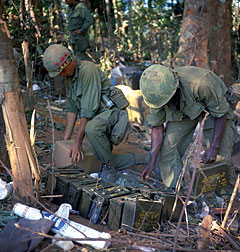 There were real flash points during the war, where battle was virtually certain. Grunts remember them only too well. At some places, the Viet Cong would react like angry wasps when American troops came near. These existed throughout South Vietnam: the U Minh Forest, the Rung Sat Swamp, Cu Chi, the Iron Triangle, the Ho Bo Woods, Binh Dinh, Bong Son, the Batangan Peninsula, the A Shau Valley. Others were points the North Vietnamese or VC were more than likely to attack: the DMZ, Lang Vei, Khe Sanh, and Dak To.
There were real flash points during the war, where battle was virtually certain. Grunts remember them only too well. At some places, the Viet Cong would react like angry wasps when American troops came near. These existed throughout South Vietnam: the U Minh Forest, the Rung Sat Swamp, Cu Chi, the Iron Triangle, the Ho Bo Woods, Binh Dinh, Bong Son, the Batangan Peninsula, the A Shau Valley. Others were points the North Vietnamese or VC were more than likely to attack: the DMZ, Lang Vei, Khe Sanh, and Dak To.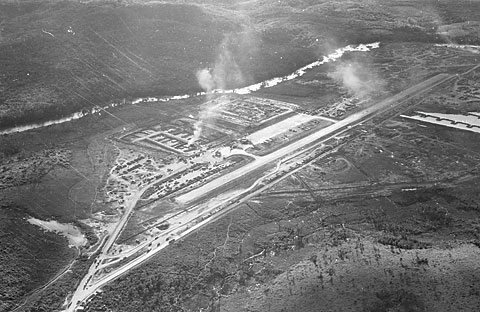
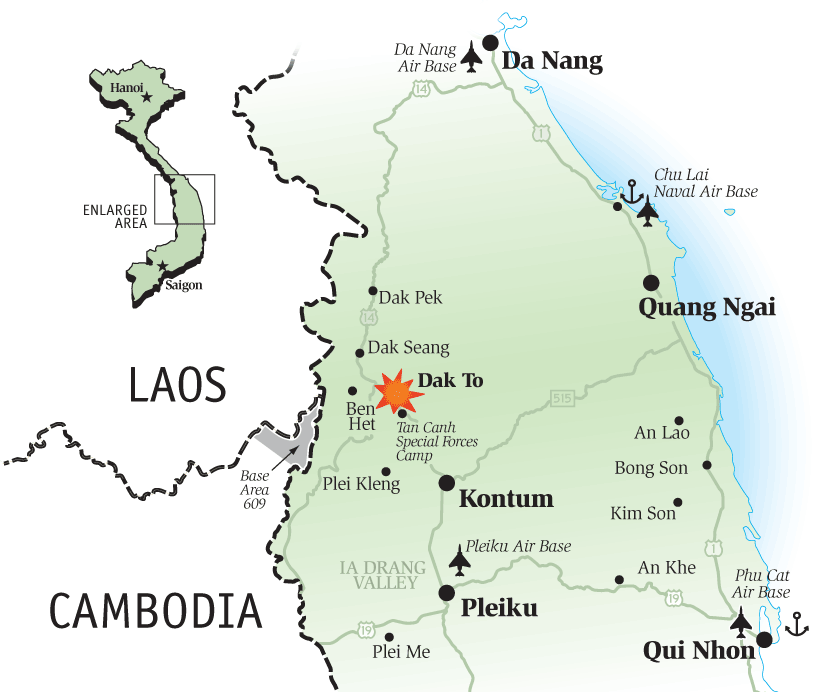
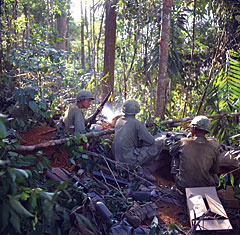 The battle for Hill 823 turned out to be only a prelude. Gen. Peers brought up another battalion, 1/8 Infantry, and the Vietnamese added two, including their 9th Airborne Battalion, used to shield Tan Canh from the enemy’s 24th Infantry. A U.S. armored cavalry troop and a tank company secured Route 14. Maneuvering along the ridge above Dak To, the 3/12th Infantry encountered new defense lines every 1,500-2,000 meters. Col. Belnap’s 3/8th Infantry, laagered for the night of November 9, were hit by mortars, B-40 rockets, and fierce attacks that went on through noon the next day. The North Vietnamese hurled more than a battalion at the position. One officer believed it was one of the biggest ground attacks of the war. Americans counted 232 enemy dead on the ground the next day.
The battle for Hill 823 turned out to be only a prelude. Gen. Peers brought up another battalion, 1/8 Infantry, and the Vietnamese added two, including their 9th Airborne Battalion, used to shield Tan Canh from the enemy’s 24th Infantry. A U.S. armored cavalry troop and a tank company secured Route 14. Maneuvering along the ridge above Dak To, the 3/12th Infantry encountered new defense lines every 1,500-2,000 meters. Col. Belnap’s 3/8th Infantry, laagered for the night of November 9, were hit by mortars, B-40 rockets, and fierce attacks that went on through noon the next day. The North Vietnamese hurled more than a battalion at the position. One officer believed it was one of the biggest ground attacks of the war. Americans counted 232 enemy dead on the ground the next day.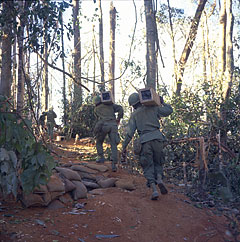 All this happened before the main event. On November 18 a Mike Force company from Dak To camp, on one of the half-dozen forays mounted by Capt. Jimmy L. Braddock’s Special Forces Detachment A-244, was working its way across the eastern slope of Hill 875 when it encountered the enemy. The North Vietnamese 174th Regiment were hunkered down in an elaborate system of trenches and bunkers. The Mike Force strikers pulled back, and the next day Gen. Schweiter sent the 2/503 up the hill. Maj. Jim Steverton’s battalion moved from where it had been exploring an abandoned enemy base camp—a huge complex which, if it mirrored the defenses on Hill 875, portended trouble for the Americans and South Vietnamese.
All this happened before the main event. On November 18 a Mike Force company from Dak To camp, on one of the half-dozen forays mounted by Capt. Jimmy L. Braddock’s Special Forces Detachment A-244, was working its way across the eastern slope of Hill 875 when it encountered the enemy. The North Vietnamese 174th Regiment were hunkered down in an elaborate system of trenches and bunkers. The Mike Force strikers pulled back, and the next day Gen. Schweiter sent the 2/503 up the hill. Maj. Jim Steverton’s battalion moved from where it had been exploring an abandoned enemy base camp—a huge complex which, if it mirrored the defenses on Hill 875, portended trouble for the Americans and South Vietnamese.